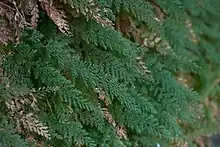Vandenboschia boschiana
Vandenboschia boschiana, synonym Trichomanes boschianum,[2] also known as the Appalachian bristle fern[3] or Appalachian filmy fern, is a small delicate perennial leptosporangiate fern which forms colonies with long, black creeping rhizomes.
| Appalachian bristle fern | |
|---|---|
 | |
| Scientific classification | |
| Kingdom: | Plantae |
| Clade: | Tracheophytes |
| Division: | Polypodiophyta |
| Class: | Polypodiopsida |
| Order: | Hymenophyllales |
| Family: | Hymenophyllaceae |
| Genus: | Vandenboschia |
| Species: | V. boschiana |
| Binomial name | |
| Vandenboschia boschiana | |
| Synonyms[2] | |
| |
Description
The evergreen fronds are bipinnatifid, deeply and irregularly dissected, about 4 to 20 cm long, 1 to 4 cm across with winged stipes 1 to 7 cm long and light green in colour. The common name derives from the leaves which are very thin, only a single cell thick, missing an epidermis and translucent, giving the appearance of a wet film.
Sori, the spore-producing organs are formed along the margins of the frond segments. The indusium forms a funnel around the sorus which is sunken in the leaf tissue. A bristle-like receptacle protrudes from the indusium as in all Trichomanes species. Spore production occurs between July and September.
In common with all ferns, V. boschiana exhibits a gametophyte stage in its life cycle (alternation of generations) and develops a haploid reproductive prothallus as an independent plant. In contrast to the typical heart-shaped fern prothallus, V. boschiana gametophytes are filamentous and resemble colonies of green algae or moss protonemata.
Taxonomy
According to the Flora of North America ploidy is rather variable. The western colonies tend to be diploid whilst the eastern ones are mostly tetraploid. Sterile triploids have also been recorded.
It has been hypothesized that most of the populations of V. boschiana are genetically identical clones of great age.[4]
Distribution
It is endemic to eastern North America. Populations are found in the eastern United States from southern Ohio in the north to Alabama in the south and from Arkansas and southern Illinois in the west to South Carolina in the east. In all areas the populations are very scattered and reflect the distribution of an uncommon habitat.
Ecology and conservation
Vandenboschia boschiana is found in deep shade on damp acid rocks, usually sandstone, of sheltered canyons, grottos and rock shelters at an altitude of 150 to 800 m. The rock outcrops are generally found within mesic upland forests.[4]
This fern is dependent upon a constantly high air humidity which places severe restrictions on its distribution in the current climate of eastern North America. In fact V. boschiana is believed to be a relict of milder pre-glacial conditions.[4] The current distribution of V. boschiana is considered to reflect historical lack of glaciation, substrate, type of bedrock, lack of disturbance in the surrounding forest and micro-climate. Temperature is perhaps less important than these factors though extreme cold weather can apparently cause mortality.[5] Periodic droughts do cause heavy mortality and have reduced many population sizes over the last few decades.[6]
The species is probably more at risk than its G4 grading would suggest and state NatureServe conservation rankings are Vulnerable (S3) to Critically imperiled (S1).
Hazards include drying of the habitat, removal of forest canopy shading the rock exposures and over-collecting.[5]
Cultivation and uses
The plant is not known to be widely cultivated. From its large-scale distribution the plant may be hardy to USDA Zone 6, although this may not reflect the micro-climate of its sheltered habitat.
References
- https://explorer.natureserve.org/Taxon/ELEMENT_GLOBAL.2.133119/Trichomanes_boschianum
- Hassler, Michael & Schmitt, Bernd (August 2019). "Vandenboschia boschiana". Checklist of Ferns and Lycophytes of the World. 8.10. Retrieved 2019-10-08.
- USDA, NRCS (n.d.). "Trichomanes boschianum". The PLANTS Database (plants.usda.gov). Greensboro, North Carolina: National Plant Data Team. Retrieved 14 December 2015.
- Hill, S.R. (2003). Conservation Assessment for Appalachian Bristle Fern (Trichomanes boschianum) Sturm. USDA Forest Service, Eastern Region
- Cusick, A. (1983). Trichomanes boschianum in Ohio. Ohio DNR
- Farrar, D.R. (1993). Hymenophyllaceae, In: Flora of North America Editorial Committee, eds., Flora of North America, Vol. 2. Oxford University Press. New York.
External links
 Media related to Trichomanes boschianum at Wikimedia Commons
Media related to Trichomanes boschianum at Wikimedia Commons- Flora of North America: Trichomanes boschianum
- Global Biodiversity Information Facility (GBIF) Data Portal: Trichomanes boschianum
- Ohio DNR: Trichomanes boschianum
- University of Tennessee Herbarium: Trichomanes boschianum
- Conservation Assessment for Appalachian Bristle Fern
Further reading
- Cobb, B. (1984). A Field Guide to Ferns and their Related Families of Northeastern and Central North America. Peterson Field Guides.
- Gleason, H. A. and Cronquist, A. (1963). Manual of Vascular Plants of Northeastern United States and Adjacent Canada. Van Nostrand, New York.
- Hill, S.R. (2003). Conservation Assessment for Appalachian Bristle Fern (Trichomanes boschianum) Sturm. USDA Forest Service, Eastern Region.
